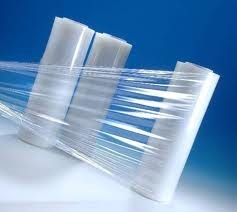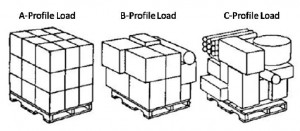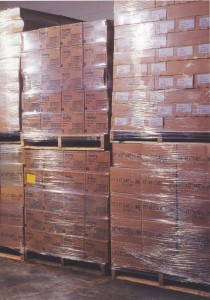
***Updated 7-23-18***
IPS Packaging stretch film terms to know
The following is a list of stretch film terms to know. This will help you fully understand the product and how it can help your packaging process.
Banding is the act of applying multiple wraps of stretch film to a certain area of a load to reinforce and/or unitize a number of layers or products. Banding is used when loads need to be completely secure. Banding packaging makes it much easier to ensure the product will reach its destination in good condition.
BFR - Conveyor
Between Frame Rails: The distance between the 2 outside frames on a conveyor section. Sometimes referred to as effective BFR, which would represent the usable width of the conveying surface.
Blown Stretch Film
A film extruded by the blown balloon type inflation system. Beads of resin are fed through a heated machine that has a circular die. The heated resin is forced through the die and then blown out vertically into a bubble. As this formed bubble finishes the process of being transformed into rolls of stretch film, it is cooled by the surrounding air. This type of blown stretch film generally costs more to make because the output per hour is less than with cast films.Typically blown film is a tougher but noisier film than cast films.

Bottom Wraps
The revolutions of film applied by a stretch wrapping system to the lower layers of a pallet or load. Typically more than one revolution is applied to this area to increase the load stability of the unitized load.
Brake Roller
A mechanical roller that provides a resistive force that reduces the film feed rate being supplied to the load. The resulting drag will create an increase in tension between the load and the stretch film roll.
Cast film
Molten plastic extruded over full width of a die, then cooled and crystallized over a drum. Cast film typically is quieter, more transparent, and glossier than blown film because of this process. Stretch film extruded by the cast method typically have greater tear resistance, greater aesthetic values and are quiet to unwind, which is not typically found in film manufactured by the blown method.
Cling (single side - two sided - differential)
Cling is a bonding agent added to stretch film to increase the stickiness quality of the film. This is desirable to allow the layers of stretch film applied to bond to the previous layers effectively creating a single wall of stretch film. Depending on the desired effect the bonding agent is applied to one or both sides. It is most commonly applied using co-extrusion where the bonding agent is a layer that is co-extruded during the manufacturing process.
CRS stands for "Cold Rolled Steel". Cold rolling occurs with the metal below its recrystallization temperature, usually room temperature, which increases the strength and also improves the surface finish and holds tighter tolerances.
Dancer Bar (Dancer Arm)
Is a pivoting roller that measures the film feed requirements of the pallet. As the pallet rotates, the stretch film needs to accelerate and decelerate around the corners to maintain a constant film force (or tension) on the load. The dancer bar pivots as the load demands more or less film fed. This is one common method by many manufacturers to measure this film feed requirement.
Erasable Programmable Read-Only Memory: An electronic device chip that provides a means for storage and communication for a microprocessor program associated with the PLC.
A piece of equipment hat uses mechanical and thermal actions to change solid polymer into a molten polymer. Extrusion A manufacturing process that takes materials from one or more extruders, the resulting extradites are then configured to the fabrication of the end product. Film Feed The speed at which the film is supplied to the load is the film feed. Film feed rate adjusts as needed on load corners to maintain consistent film tension.
Film Feed
As a film is applied to a load the speed or velocity at which it is applied is called film feed. The feeding of the film is rarely constant as it must be accelerated and decelerated to compensate for the corners of the load to keep the film tension constant. Without this corner compensation feedback the film tension would increase as at the corners causing potential damage or film breakage issues.
Film Force (Film Tension)
Film Force is the retaining force applied by the stretch film on the product being wrapped. This force is typically measured in pounds. Film force is created two ways. The second method is by delaying the film feeding out of the carriage. During wrapping the film is fed out at a constant tension. By delaying the response (speed) of the carriage film feed, you electronically increase the film tension. A film force dial is typically located on the control panel or carriage.
Film Force Release
A feature typically used on automatic stretch wrapping equipment whereby the film force feature is disabled for a time at the beginning and end of the cycle. This feature prevents unwanted tension at the two points during the cycle where added tension would create problems. The stretch film pulling out of the clamp at the beginning of the cycle and the detaching of the trailing tail at the end of the cycle are typically remedied by film force release.
Film Gauge
Is the imperial measurement used for measuring film thickness.
Film Memory
Film memory is THE key reason for prestretching stretch film. Prestretching stretch film creates a memory in the film, which causes a continuous elastic effect as the film tries to return to its unstretched self. This ensures that the load integrity is maintained even as the load shifts or settles during transit. It is this film memory that differentiates prestretched film from non-prestretched film or other means of unitizing. For instance, settling that occurs during shipment can loosen other methods of unitizing (strapping) where prestretched film memory takes up the slack and continues to secure the load.
Film Recovery
Film recovery describes the extent in which a material returns to its original shape and size after having been deformed or subject to stretching. This assures that the film will maintain a tight load during transportation.
Film Tail
The film tail is the stretch film end piece that is applied to a pallet or load to start a wrapping cycle. It is also the stretch wrap end piece created when cutting the film at the end of the wrapping cycle.
Force Load
Force to load varies by number of wraps, gauge being used, force to load settings on machine, pre-stretch level of machine. The most typical force to load seen is 15-26 lbs in the field.
A unit of measurement that is used to measure stretch film thickness or caliper. An example value would read as: 40 gauge, 60 gauge or 100 gauge. Also note: Often used as a synonym for film thickness.
Hand Wrap
Stretch film designed to be post stretched or tensioned stretched by personnel without equipment is called hand wrap. Typically hand wrap does not have the stretching abilities of machine wrap and is wound on smaller and lighter rolls for easier manipulation. Designed for hand wrapping application, hand film rolls are lighter and smaller than machine film rolls to make application easier.
Refers to lack of clarity and inability to see through a film, it is measured by the percentage of light not transmitted through a film sample. Characteristic is typical of blown stretch films.
Home Position
Home position is the position of all the moving sub assemblies on a stretch wrapping machine when they are at rest and ready to begin a new cycle.
Idler Roller
Idler rollers are used to bias the stretch film direction as it travels through the prestretch carriage. In some cases it is to ensure that the stretch film is maintained against the prestretch rollers to prevent the film from slipping by the prestretch roller.
LLDPE Stretch Film
Linear Low Density Polyethylene Stretch Film
Load Types - A-load, B-Load, C-Load
Stretch film and machine manufacturers have divided the types of loads wrapped into three load types based on the degree of difficulty to wrap the load or product.
A-Load: Is the simplest of the load types. Usually a std. pallet with no sharp edges, clean sides without obstructions that may interfere with the application of the stretch film
B-Load: This load type may have
C-Load: The most difficult type of load. It may be unstable, with sharp corners that may have an effect on speed

Load Diagonal
Is the measurement of a pallet or product load across the diagonally opposite corners. This dimension is critical in determining the overall size of a stretch wrapper. The difference in this dimension in the largest load to be wrapped and the smallest can also effect how the machine needs to be designed. The equation for determining a load diagonal of any pallet is (L2 + W2).
New polyethylene resins developed using "Metallocene" change the polytheylene chain structures resulting in a new breed of stretch films. Metallocene stretch films can achieve increased puncture resistance and clarity while blends offer balanced film properties and universal stretch percentage applications (ex: machine film, hand film).
Is the metric measurement used for measuring stretch film thickness. One micron is equal to one millionth of a meter.
As film is stretched there is a tendency for the film to narrow (similar to bubble gum). This narrowing of the film is called neckdown. Neckdown reduces the coverage a revolution of stretch film provides thus potentially increasing the number of revolutions required to wrap a pallet or load. The larger the distance between the two rollers stretching the film (Primary & Secondary prestretch rollers) the larger the neckdown.
National Electrical Manufacturers Association: An association that rates electrical devices for uses in various environments. Eg. NEMA 12 rated devices are intended for in-door use and provide a degree of protection from circulating dust and dripping non-corrosive liquids. NEMA 4 rated device are intended for indoor/outdoor use and provide a degree of protection from blowing dust and splashing non-corrosive fluids.
As stretch film is applied to a load the stretch film is typically applied so that the next layer of stretch film is applied over the previous layer. This overlapping of film layers increases load retention. By slowing the vertical movement of the stretch film carriage the larger the overlap created.
Is the amount of stretch film applied over the top of the load. As the stretch film reaches the top of the load, the vertical movement of the carriage can continue so that the film angles over the top of the load. The stretch film on top creates a downward force on the pallet load. This is also used when a plastic top sheet or corrugated top cap is applied on the top of the load to lock them in place.
Programmable Logic Controller: An electronic microprocessor device that stores and executes automatically a series of programmed commands that produce a machines sequence of operation.
Poststretch (See Tension Stretch)
Prestretch Film
Prestretch is the process of stretching the film in a prestretch carriage PRIOR to (Pre-) applying it to the load to be wrapped. As the stretch film passes through the carriage it threads past two rubber rollers (Primary roller & Secondary roller). The secondary roller is usually larger than the primary roller and its rotational speed is geared to be faster than the primary roller. This differential of speed where the secondary roller is pulling the film from the primary roller causes the film to stretch between the two, thus prestretching the film between one and the other.
Prestretch Carriage
Is the assembly n a stretch wrapper that stretches the film prior to applying it to the load. Located on a vertical traveling slide, the pre-stretch carriage applies a spiraling layer of stretch film to the load thus encapsulating the load in stretch film.
Primary Roller
Is one of two rubberized rollers located in the prestretch carriage used to create prestretched film. The primary roller is the first rubberized roller the film passes by and is usually the smaller of the two. Its speed is also geared slower than the secondary roller.
Gathering the full width of the film using a bar or roller so that it creates a "rope" is called roping. Stretch film that has been roped is nearly unbreakable and is most often used to lock a pallet to the product. This is easily done with a turntable style machine. With rotary arm style machines an air cylinder can be used to actuate the roping process. In some cases, roping has eliminated the need for other packaging materials such as strapping.
SCR - Motor Control Board
Silicon Controlled Rectifier A means of controlling a DC motors rotation speed.
Secondary Roller
Is one of two rubberized rollers located in the prestretch carriage used to create prestretched film. The secondary roller is the second rubberized roller the film passes by and is usually the larger of the two. Its speed is also geared faster than the primary roller.
Additives used in the material fabrication process to increase the "tack" of the film or material
Tear Resistance
Refers to the resistance of the film to tear. Attribute is quantified by measuring the force needed to propagate an initiated tear. Tensile Strength Tensile strength a measurement of the maximum amount of force a material can take without breaking. The greater the tensile stretch measurement, the stronger the material.
Tension Stretch
Tension stretch (or post stretch) is the method of stretching the film by pulling (or tensioning) while the film is applied to the pallet. Although this increases the film force, the load being wrapped limits this tension. Empty PET bottles or light boxes will be crushed or damaged by high-tension stretch. Layers of product can be swept of a pallet and film breaks also increase as the tension stretch is increased.
Top Sheet Dispenser
Top sheet dispenser is a piece of equipment that applies a poly sheet of plastic top sheet to the top of a load to provide a water resistant layer. Typically, once applied, a top sheet is subsequently wrapped with stretch film to secure it in place. The top sheet film is unrolled, cut to size, and applied to the load automatically by the top sheet dispenser.
Top Sheet Film
Is the poly plastic film that is applied to the top of the load
Top Wraps
Top wraps are the extra revolutions of stretch film applied to the top portion of the load to be wrapped. As the top layers are susceptible to shifting in transit extra layers of stretch film (top wraps) is applied. These extra revolutions are typically set using the top wrap counter located on the control panel.
Ultra High Molecular Weight: A type of plastic commonly used in applications where a linear bearing between sliding assemblies is required. Low wear and reduced friction properties make this a commonly used product in stretch wrap equipment.
VFD - Variable Frequency Drive
A device used to provide full control of an AC motors shaft rotation speeds. VFDs offer a wider range of features as seen on SCR DC motor control board (see SCR). Features include, display diagnostics, multiple step speed control features and fully reset-able from voltage problems such as power surges.
Wrap Parameters
Wrap parameters are the variable settings on a stretch wrapping system that can be adjusted to meet the load retention requirements of the product to be wrapped. These parameters typically include settings like: Top wraps, bottom wraps, film carriage vertical speed, turntable (or arm rotation) speed, and film force.
*Editor's note. This post was originally published on November 3, 2011 and has been updated with the most up to date content.







